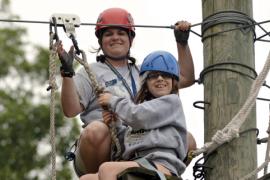Though the idea of working to include disabled people in all facets of life is an old idea, it has relatively recent regulatory roots. Beyond being a good idea, that concept has been the proverbial “law of the land” since the adoption of the Civil Rights Act of 1964. That’s right; the same sweeping legislation that did away with segregation based on race also sought to bring another group of historically overlooked people into the mainstream. So in addition to not excluding people by forbidding them entry, the Americans with Disabilities Act (ADA) was developed to remove more subtle, passive barriers that prevented people from coming and going as freely as they were able. More recently, the ADA has been amended to address 279 pages worth of issues and barriers that have hampered disabled people’s access to many of the everyday pieces of life that the able-bodied largely take for granted. This month, we’re going to look at some of the features that are most likely to affect the camp community.
What’s the ADA Cover?
It may be hard to believe, but there are only 53 pages that broadly describe impediments to the disabled that must be overcome in design, construction, and operation of the regulated facility. These pages include all sorts of issues from parking spaces and passageway projections to corridor widths and threshold heights. (There are dozens more.) In turn, building codes dedicate hundreds (if not thousands) of pages describing compliance. Again, understanding and applying this web of rules is part and parcel of the code-savvy professional’s everyday work. Given time to reconcile your requirements for the facility with those contained in the building code, smart people make you money by developing compliant, permissible, and buildable solutions. Give them the chance to serve you well by bringing them in early and paying them for their expertise. This is NOT the time to ask a “friend of camp” to “see what they can do to help.” Failure to reasonably adhere to requirements could cost tens of thousands of dollars.
Do the Changes Affect MY Camp?
Like eating oatmeal (the commercial tells us), it’s the right thing to do. Camp is, at its heart, the first and best home of inclusion. At camp, young people — campers and staff alike — learn by exposure what it is to contend with challenges that most never even imagine. The ADA regulations and building codes contain instructions and guidance that can help make your facility a more welcoming and inviting place for lots of guests to enjoy and to grow. Even if your organization is exempt from individual requirements and mandates, work with your design professionals to consider whether you can include features that will make your guests better able to enjoy the facility; not because you have to, but simply because it’s the right thing to do.
By and large, the answer to the question of whether or not the changes affect your camp is yes. However, it’s IMPERATIVE for each and every organization to have legal counsel confirm that’s the case for them. That’s because the 2010 ADA document is written to the regulated community. So before you begin, it only makes sense to be sure that camp is indeed the target of the regulation. It is, like most laws and rules, a complex morass of cross references. But the phrase that should catch counsel’s attention is that private clubs and religious organizations are exempt from ADA’s Title III requirements for public accommodations and commercial facilities. Since each organization is unique in one way or another, it will require careful, knowledgeable, competent legal research to make a solid recommendation on how to proceed. And make no mistake: This money and time is well spent; the costs for compliance can be steep for sure.
I’m Seeing Dollar Signs . . .
Since we’re already talking about costs, it’s probably time to talk about money. There is much space in the ADA spent claiming that costs associated with accommodations should be “reasonable.” For the camp that has no intentions of ever hosting disabled guests, all of the costs may be perceived to be unreasonable, and therefore the camp shouldn’t have to comply at all. That argument’s already been dismissed. But while I believe it’s already lost, your legal team should verify that’s the case for your organization. However, the language remains in the ADA requirements, and standards have been set such that arguments have been successfully made on a case-by-case basis. Certain issues have been resolved in the 2010 revision. For example, many organizations argued successfully that making facilities wheelchair accessible didn’t make sense because access to the building itself wasn’t wheelchair or vehicle accessible. That disconnect was resolved in the latest revision by including site access requirements to make the building accessible. So before beginning any project, you should thoroughly educate yourself and make sure that the ADA requirements apply to your organization in general — and your project specifically. One particularly great resource is a Q & A page found here: www.eeoc.gov/facts/adaqa2.html.
What about Altering Existing Stuff?
Section 36.402 addresses alterations of existing facilities. It includes language with phrases such as, “to the maximum extent possible,” as well as standards for those alterations and new construction. For example, we’ve all seen the “I had to add on a wheelchair ramp” addition to a building that doesn’t fit, look right, or really work well. Often, poor planning, late involvement by a professional, or plain ignorance (by a code official or builder) has forced a one-size-fits-all solution into an inconvenient location. With time and planning, though, smarter, more-functional, and less-intrusive ideas can be developed. As a bonus, organizations whose capital improvements hinge on donors’ generosity will find that money is much easier to come by when the need and response is well thought out and smartly implemented.
It’s Not All Bad News!
The best news here, though, is that implementing ADA requirements remains an incremental process, so wholesale upgrades across the property or throughout a building aren’t required. So if you’re building or rebuilding a cabin, you don’t need to upgrade the arts cabin or the dining hall. However, if you need to excavate to correct a leak in the swimming pool, that sort of structural repair may very quickly line up your camp for the addition of guest lifts, ramps, or other accommodations. Furthermore, even though local officials may assert that changes in the pool equipment room (like changing pumps or chemical feed systems) constitute a “significant change,” that sort of very thin argument has already been resolved. But don’t count on making this case yourself or expecting the local excavator who does all of the work on the pool to win that battle: You’ll need your code-savvy architect or engineer to advocate for you. This is also an important distinction. Your representative needs to understand your situation completely and be willing to make and pursue the best course for your organization and facility, much like an attorney. He or she needs to have a very strong sense of how to “pick the right battles” to spend their time and your design budget wisely. Understand that if they are successful, paying them may return savings of ten to one or more in the construction budget. So, waste no time! Be proactive and get them involved from the beginning — you’ll only have one real chance to get this right.
Swimming Pools
As an example of how complicated the ADA can be, let’s look at part of the rules for swimming pools. Here’s a direct quote (thank goodness for cut-and-paste!) from the 2010 ADA:
|
242.2 Swimming Pools. At least two accessible means of entry shall be provided for swimming pools. Accessible means of entry shall be swimming pool lifts complying with 1009.2; sloped entries complying with 1009.3; transfer walls complying with 1009.4; transfer systems complying with 1009.5; and pool stairs complying with 1009.6. At least one accessible means of entry provided shall comply with 1009.2 or 1009.3. EXCEPTIONS:
|
This excerpt is saying that most full-size pools in commercial settings at regulated facilities will be required to have two accessible accesses. The requirement is met using a combination of lifts, a sloping bottom, transfer walls, transfer systems, or special pool stairs. It’s a requirement that at least one entry must be a lift or a sloped entry, and they recommend employing two different methods. The key word there is “recommend.” That kind of language is where your designer makes you money, since a plan reviewer may well not remember that and attempt to require different methods. Having someone on your team who knows the rules and is being paid to advocate for your camp will argue successfully on your behalf. You can also see that there are exceptions to these requirements. First is an exception for relatively small pools with a perimeter less than 300 feet. To put that in perspective, a competitive swimming pool at 25 yards (75 feet) long could have fourteen lanes that are 5 feet wide and not exceed that limit of 300 feet. The disabled patron entry requirement can be met with only one installation of the allowed methods instead of two. The second exception concerns specialty water facilities that by design have only one entry point, in which case, again, only one accessible entry is required. Note, however, that there simply is no swimming pool size that is inherently exempt from accessibility requirements. So while one special accommodation costs less than two, zero accommodations cost less than one. Knowing for certain whether the rules apply in the first place could save thousands of dollars of capital costs for facilities that aren’t actually required by the ADA.
Rick Stryker is a professional engineer with a particular passion for helping camps with infrastructure, planning, and regulatory issues. He can always be reached at campfc@ptd.net or 570.828.4004.
Originally published in the 2013 March/April Camping Magazine.


